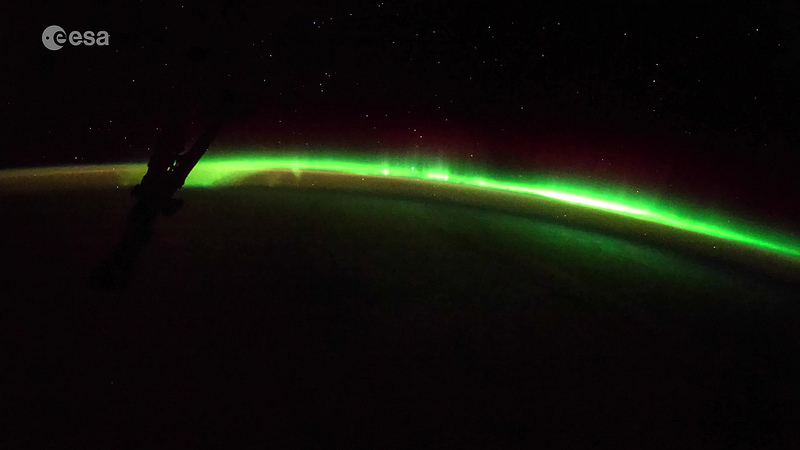Astronaut's Time-Lapse Video Features Auroras and Brilliant Sunrise

French astronaut Thomas Pesquet caught stunning views of auroras and a sunrise over Earth from the International Space Station, woven into a new time-lapse video.
"The first bright rise… is not the sun!" Pesquet wrote on Twitter yesterday (May 17) — and indeed, amid the twirling auroras first the moon and then the planet Venus emerge over the horizon before bright sunlight fills the screen. The video, which was put together on Earth, plays at 25 times the actual speed, European Space Agency officials said in a video description.
The vivid green aurora visible in the time-lapse comes from charged particles jettisoned from the sun drawn toward the north and south poles of Earth's magnetic field, hitting neutral particles in the upper atmosphere and letting off colorful light. The shine of airglow — light emitted from Earth's atmosphere — is also visible bordering the planet.
Pesquet has been on the space station for 26 weeks along with NASA astronaut and space station commander Peggy Whitson and Russian cosmonaut Oleg Novitsky. Last month, they were joined by NASA astronaut Jack Fischer and Russian cosmonaut Fyodor Yurchikhin. Pesquetfrequently posts photographs of Earth from space as well as life on the station.
All week, the crewmembers have been working on the Genes in Space studies, analyzing DNA samples from the orbiting lab to see how spaceflight affects telomere length, according to NASA's space station blog. On Tuesday, Pesquet and Novitskiy tried on a suit intended to alleviate eye and head pressure while in microgravity.
Whitson and Fischer recently undertook the 200th spacewalk in service of the space station to replace an avionics box — Pesquet had originally been scheduled for that spacewalk, but the part's delivery on Orbital ATK's Cygnus spacecraft was delayed long enough that the spacewalk occurred after Fischer's arrival. Instead, he helped them prepare and maneuvered Fischer using the station's robotic arm, Canadarm-2, to carry him over to the worksite.
Pesquet and Novitskiy are scheduled to head back for Earth on June 2, touching down on the steppes of Kazakhstan after spending six months in space. These last 15 days may be busy ones — but should also offer Pesquet plenty of time to capture more images from his unique viewpoint.
Get the Space.com Newsletter
Breaking space news, the latest updates on rocket launches, skywatching events and more!
Email Sarah Lewin at slewin@space.com or follow her @SarahExplains. Follow us @Spacedotcom, Facebook and Google+. Original article on Space.com.
Join our Space Forums to keep talking space on the latest missions, night sky and more! And if you have a news tip, correction or comment, let us know at: community@space.com.

Sarah Lewin started writing for Space.com in June of 2015 as a Staff Writer and became Associate Editor in 2019 . Her work has been featured by Scientific American, IEEE Spectrum, Quanta Magazine, Wired, The Scientist, Science Friday and WGBH's Inside NOVA. Sarah has an MA from NYU's Science, Health and Environmental Reporting Program and an AB in mathematics from Brown University. When not writing, reading or thinking about space, Sarah enjoys musical theatre and mathematical papercraft. She is currently Assistant News Editor at Scientific American. You can follow her on Twitter @SarahExplains.









